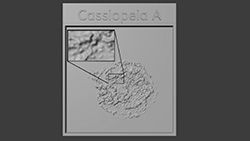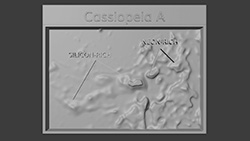CXC Home | Search | Help | Image Use Policy | Latest Images | Privacy | Accessibility | Glossary | Q&A
1
X-ray Images of Cassiopeia ACredit: X-ray: NASA/CXC/Meiji Univ./T. Sato et al.; Image Processing: NASA/CXC/SAO/N. Wolk
This graphic features Chandra data of the Cassiopeia A (Cas A) supernova remnant that reveals that the star’s interior violently rearranged itself mere hours before it exploded. The main panel of this graphic is Chandra data that show the location of different elements in the remains of the explosion: silicon (red), sulfur (yellow), calcium (green) and iron (purple). The blue color reveals the highest-energy X-ray emission detected by Chandra in Cas A and an expanding blast wave. The inset reveals regions with wide ranges of relative abundances of silicon and neon. These data, plus computer modeling, reveal new insight into how massive stars like Cas A end their lives.
2
Cassiopeia A: Schematic IllustrationCredit: NASA/CXC/Meiji Univ./T. Sato et al.
An illustrated figure showing a cross-section of a massive star similar to the one that created the Cas A supernova remnant. The onion-like layers are dominated by heavier and heavier elements, beginning with hydrogen, and extending to helium, carbon, oxygen, silicon and iron in the center of the star. The cross-section is shown a few hours before the star's explosion as a supernova. Silicon-rich material made in nuclear reactions involving oxygen (in the narrow "O-burning shell"), are buoyant and push outwards in silicon-rich plumes, forcing neon-rich material further out to flow inwards. The motion of these silicon-rich and neon-rich materials disrupt the narrow shell where carbon and neon are undergoing nuclear reactions (the narrow "C-/Ne-burning shell").
3
3D Printable Files: Cassiopeia A, Image with Inset(3D Print Credit: NASA/CXC/A. Jubett, using software by Tactile Universe/N. Bonne & C. Krawczyk & Blender)
3D Printable Files: Cassiopeia A, Inset Only
(3D Print Credit: NASA/CXC/A. Jubett, using software by Tactile Universe/N. Bonne & C. Krawczyk & Blender)
(3D Print Credit: NASA/CXC/A. Jubett, using software by Tactile Universe/N. Bonne & C. Krawczyk & Blender)
This tactile plate pair shows two physical relief maps, both based on the intensity of Chandra X-ray data, featuring Cassiopeia A, a filled donut-shaped supernova remnant located about 11,000 light-years from Earth. Included in the plates is the main plate, featuring the full object and showing the inset region, and an inset closeup plate, which highlights a region with relative abundances of silicon and neon.
Over three hundred years ago, Cassiopeia A, or Cas A, was a star on the brink of self-destruction. In composition it resembled an onion with layers rich in different elements such as hydrogen, helium, carbon, silicon, sulfur, calcium, and neon, wrapped around an iron core. When that iron core grew beyond a certain mass, the star could no longer support its own weight. The outer layers fell into the collapsing core, then rebounded as a supernova. This explosion created the filled donut-like shape shown in the main plate. The shape is somewhat irregular, with the thinner quadrant of the donut to the upper left of the off-center hole.
In the body of the donut, shown in the main plate, the remains of the star’s elements create a mottled cloud of texture, marbled with spidery veins. Here, the mottled regions represent sulfur, calcium and iron. Some of the tangles of veins are silicon, and other veins, which also line the outer edge of the donut-shape, are the highest-energy X-rays detected by Chandra and show the explosion’s blast wave. A raised box denotes the region featured in the other (inset) plate.
The inset plate highlights a close-up, mottled region at the thinner, upper left quadrant of Cas A. Here, rich pockets of silicon and neon are identified by labels. New evidence from Chandra indicates that in the hours before the star’s collapse, part of a silicon-rich layer traveled outward, and broke into a neighboring neon-rich layer. This violent breakdown of layers created strong turbulent flows, and may have promoted the development of the supernova’s blast wave, facilitating the star’s explosion. Additionally, upheaval in the interior of the star may have produced a lopsided explosion, resulting in the irregular shape, with an off-center hole (and a thinner bite of donut!) at our upper left.
Over three hundred years ago, Cassiopeia A, or Cas A, was a star on the brink of self-destruction. In composition it resembled an onion with layers rich in different elements such as hydrogen, helium, carbon, silicon, sulfur, calcium, and neon, wrapped around an iron core. When that iron core grew beyond a certain mass, the star could no longer support its own weight. The outer layers fell into the collapsing core, then rebounded as a supernova. This explosion created the filled donut-like shape shown in the main plate. The shape is somewhat irregular, with the thinner quadrant of the donut to the upper left of the off-center hole.
In the body of the donut, shown in the main plate, the remains of the star’s elements create a mottled cloud of texture, marbled with spidery veins. Here, the mottled regions represent sulfur, calcium and iron. Some of the tangles of veins are silicon, and other veins, which also line the outer edge of the donut-shape, are the highest-energy X-rays detected by Chandra and show the explosion’s blast wave. A raised box denotes the region featured in the other (inset) plate.
The inset plate highlights a close-up, mottled region at the thinner, upper left quadrant of Cas A. Here, rich pockets of silicon and neon are identified by labels. New evidence from Chandra indicates that in the hours before the star’s collapse, part of a silicon-rich layer traveled outward, and broke into a neighboring neon-rich layer. This violent breakdown of layers created strong turbulent flows, and may have promoted the development of the supernova’s blast wave, facilitating the star’s explosion. Additionally, upheaval in the interior of the star may have produced a lopsided explosion, resulting in the irregular shape, with an off-center hole (and a thinner bite of donut!) at our upper left.
Return to: NASA's Chandra Reveals Star's Inner Conflict Before Explosion (August 28, 2025)










